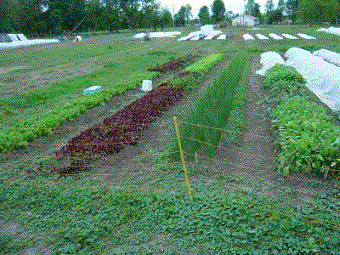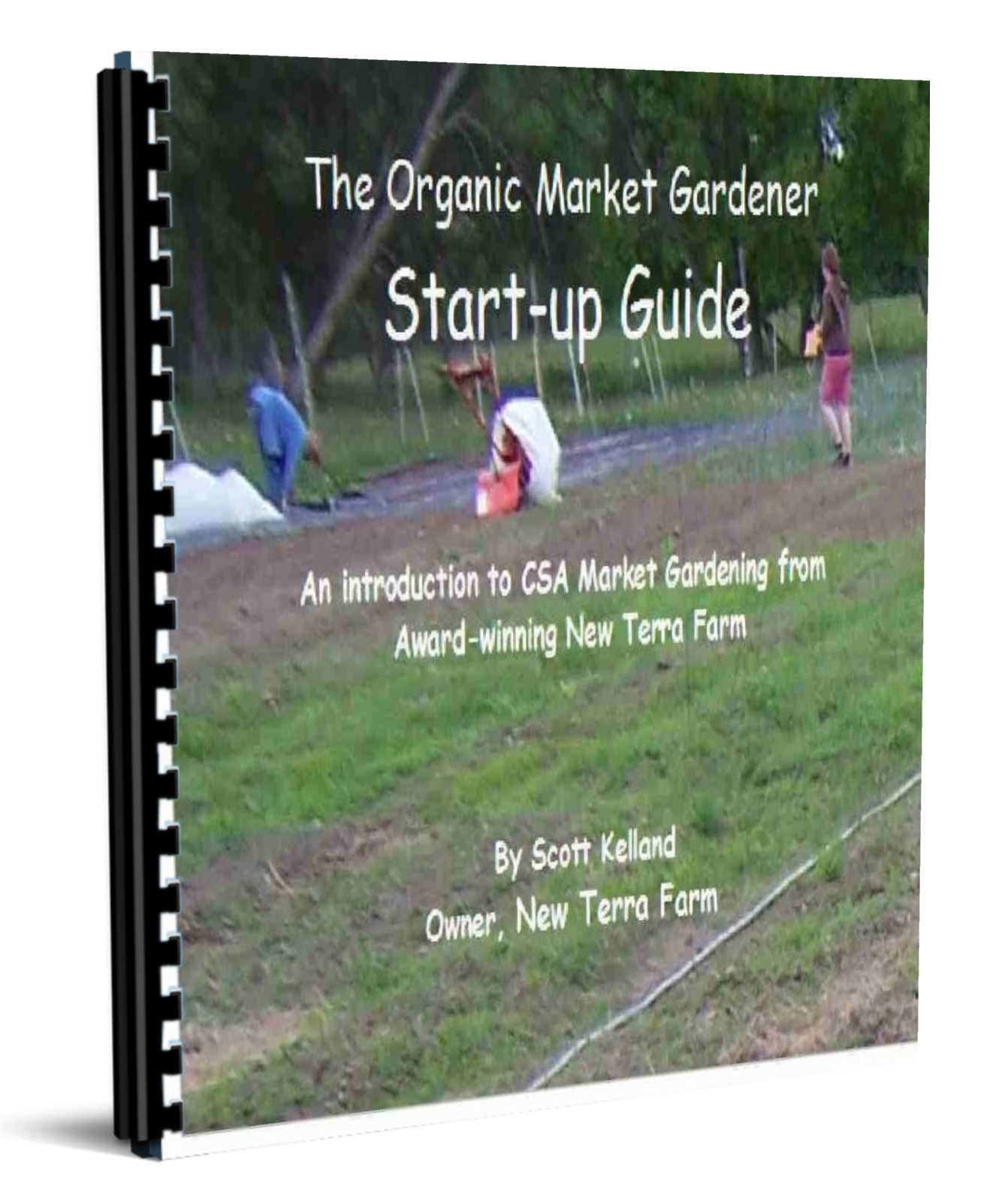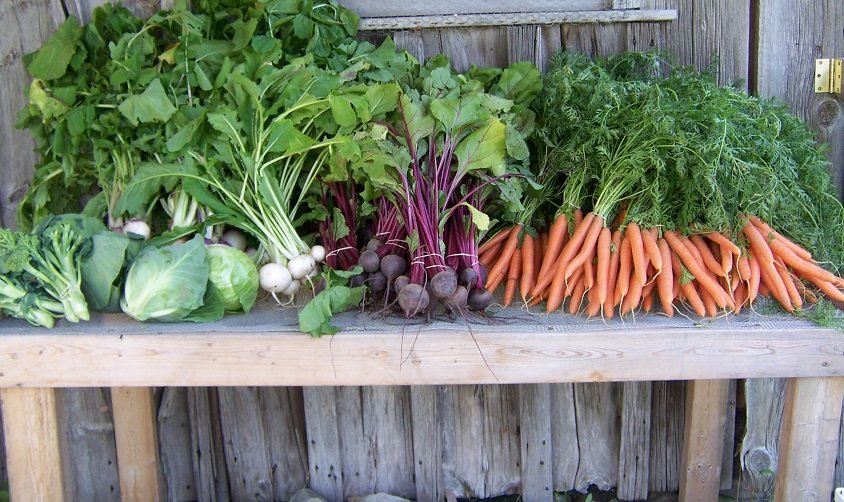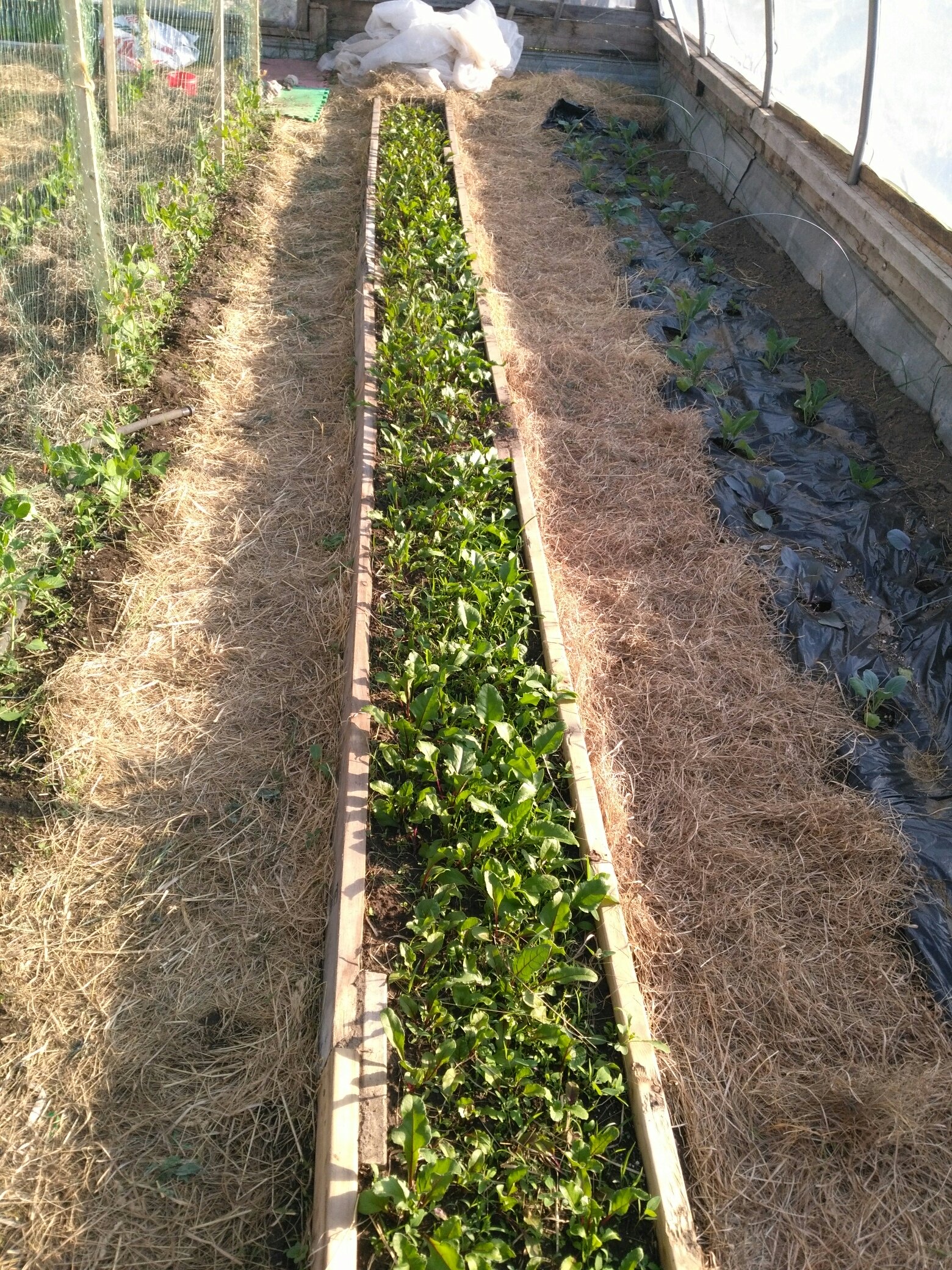Growing a high income market garden
 My market garden laid out for efficiency and productivity
My market garden laid out for efficiency and productivityGrowing a high income market garden is within the reach of most growers. It's possible to gross $40,000 or more from a one-acre garden, but achieving this revenue depends on careful crop selection, good marketing, and efficient work methods.
Here are some suggestions for the most profitable crops to grow in your market garden:
Planning assumptions for the high income market garden
First, its not what you make, its what you keep. In other words net income is more important than gross income. For example, green salad mix (mesclun) is a high-value crop on a per square foot basis, but the cost to pick and clean and dry it before packaging is also high. Be aware of the labour cost of your crops - even if you are doing all the picking yourself.
Second, you are operating an organic high income market garden. This means you are growing a complex polyculture using sustainable methods. I will assume you aren't growing anything as a commodity. Small market gardens can't compete with the factory farms on price or volume; you have to compete on quality. The premium market is organic.
Third, you need to stretch out your cash flow by growing crops that yield as early and as late in the season as possible. Tomatoes are popular and profitable, but if that's all I grew I would have 8 or 10 weeks of income, perhaps less.
Read more about scheduling your market garden here
Fourth, you are going to sell your garden wares direct to your end customers at a farmers market or by starting a Community Supported Agriculture (CSA) operation. Small market gardens can't afford 'middlemen'.
When I was researching for my Bootstrap Boot Camp Small Farm Success Plan Course, I discovered that CSA market gardens typically yield the highest net income of all small farms.
Finally, be aware of local conditions and preferences. Popular crops in your area may not be on this list, so check out some local markets to see what's selling.

The consumer demand for fresh local organic food has never been higher. Bad news on the supply chain is good news for local growers.
Get my free Organic Market Gardener Start-up Guide and see if this is the right time to launch your CSA market garden business.
Crop selection for the high income market garden
 I love my garden!
I love my garden!Here's what I have been growing in my high income market garden, with a rationale for each crop. This selection is appropriate for my location and resources.
If I was starting from scratch to plan a high income market garden, some of my choices would be different. Check out my latest Special Report 'Grow the Top Ten Most Profitable Vegetables' to see other options.
Tomatoes and peppers (sweet and hot) are all reasonably high value and high yield. Differentiate your garden by growing especially tasty or heirloom varieties. Grow indeterminate tomatoes and trellis or cage them for an extended harvest. You can grow a mix or red, orange, and yellow cherry tomatoes to make a colorful and profitable display.
And check out my recommendation for sweet peppers here.
The vining crops like cucumbers and summer squash are prolific and popular. If kept picked they will produce over an extended harvest period. Try some unusual or specialty varieties like lemon cukes. Make an early-summer and a mid-summer planting (but at least 12 weeks before your fall frost date) to stretch the harvest.
Bunching onions pay more per square foot than slicing onions,and are ready earlier in the season. I do grow some slicing onions, of the large, sweet type (Walla Walla or Candy). The basic yellow storage onions are not profitable in a small market garden.
As mentioned, some crops are reasonably high value per square foot, but expensive to pick and process. Snap beans fall into this category. Some varieties of snap beans will keep producing over a long period (I like 'Provider'), and thus yield quite well.
But they are time consuming to harvest. Picking a pound of tomatoes takes 5 seconds; a pound of beans, 5 minutes. They are popular, so grow some, but be aware of the cost. You won't make a lot of profit on beans
Many herbs sell for more per square foot than actual food crops. I would start with the annual herbs like cilantro, dill, and basil. They command a nice price, and cilantro and dill can be direct-seeded beginning quite early in the season.
Unless you have a lot of land, and specialized equipment, stay away from potatoes as a main crop. The yield per square foot and price per pound are low. Dealing with potato bugs organically on a large scale requires specialized equipment like vacuum systems or 'sweep and collect' jigs that run from a tractor.
And digging a few hundred (or thousand) feet of potatoes by hand may be more exercise than you want. If you want to grow potatoes for your customers grow some specialty 'fingerling' types.
The root crops are not especially profitable, but you may develop a 'following' for them. In order of popularity (in my experience) the common root crops are carrots, turnips, beets, and rutabaga.
I do devote a little greenhouse space to an early crop of carrots and beets, here's why. All the root crops require diligent weeding and thinning to produce good-sized roots. They also all have the potential to stretch the season. I would recommend devoting some garden space to the first three; I wouldn't grow rutabaga unless you had customers that specifically ask for it.
 Big bed of early beets in my greenhouse
Big bed of early beets in my greenhouseIf you want to grow cole crops, stick to cabbage and broccoli – cauliflower is finicky, and more easily damaged by weather and bugs than the others. Leave it out of your high income market garden.
Be aware that I absolutely cannot grow broccoli or cabbage without row cover;
the bugs just love these crops. This adds to the labour cost. Some of
the more unusual cabbages command a higher price (Tall Michilhli is a
favorite of mine)
Lettuce is a popular crop, quick and easy to grow (except in real
hot summer conditions) and can be harvested both early and late in the
season. Grow multiple varieties and look for heat-tolerant cultivars for
summer growing.
A final option: It's an interesting fact that people will pay more
for ornamental plants than ones they can eat. If you have the space in
your greenhouse, you could grow some bedding plants for early sales at
your market.
Operating a nursery as your main enterprise is a risky business;
it's a highly competitive industry, and you need specialized, automated
equipment to succeed.
But as a sideline, growing a few hundred bedding plants alongside your other plants can bring a nice early cash flow to your garden. You can read more about How to start a backyard nursery here
Laying out your high income market garden
So to wrap it all up, what would your high-income market garden look like? Here's an idea of the space to allocate for each crop, based on profit, popularity, and growing room needed.
- Vining crops (cukes, summer squash) – 20%
- Tomatoes (cherry and slicing types) – 15%
- Carrots, turnip, beets – 10%
- The cole crops (broccoli, cabbage) – 10%
- Lettuce and salad greens – 10%
- Potatoes (fingerling or specialty) - 10%
- Peppers (sweet and hot) – 10%
- Onions (bunching and sweet) - 5%
- Snap beans – 5%
- Annual herbs – 5%
Two final notes about the above:
1 - I didn't allocate garden space to the bedding plants; they will be mostly grown in your greenhouse.
2 - this is not a prescription; consider this list of plants just a starting place for your own research and planning to build your own high income market garden.
More like High Income Market Garden
7 Farm Side Hustles that can increase your farm income.
Build a Lean-To Greenhouse to start your plants and keep them thriving. Instructions to build a lean-to just like the first one I built at New Terra Farm.
Check out my list of essential micro-farm equipment
Even in a cold climate extending the garden season beyond what most people think is possible is very feasible. And you can do this without breaking the bank. Learn more about extending the garden season here
Looking to increase self-sufficiency on your homesteaded (no matter how small)? The Self-Sufficient Backyard is a great resource.
You've grown some wonderful veggies in your market garden and now the time has come to sell them. So you head off to the farmers market, right? Wrong! If you are a market gardener (or want to be one), CSA may be a better model.
What does it take to start your own CSA market garden? I put together this Get-Started Checklist to give you an idea to the timing and the tasks if you want to start growing for market
Market gardeners need customers; customers come from effective marketing. Here's the Secret Marketing Weapon that built us TWO successful work from home businesses.
If you are thinking about market farming as a career, here's a few points to consider before you take the leap.
You may just have put your market garden to bed for the winter (if you are in the northern hemisphere) but now is the time to start your market garden plan for next season.
I like reading old farming books; much of the market gardening advice given 50 or 100 years ago is still valid today. Here's some tidbits from a market gardening book published in 1882 called Gardening for Profit .
A market gardening business plan is absolutely necessary, if you are seriously thinking about making money from your garden. Here's what is in the New Terra Farm plan
We've said before that market gardening is as much about 'marketing' as 'gardening'. Here’s some valuable information about promoting your bootstrap market garden (or any farm business).
Here's a great FREE resource for the small grower. Sustainable Agriculture Research and Education.
My Best Book Deals...
Based on 20+ years of gardening and farming experience, I wrote some books that show you practical approaches to gardening and raising small livestock. If you want to fill your freezer and cold storage with your own healthy, nutritious food, and provide some real food security for your family, it might be worth a look here.
I just put together two special book deals:
- If you are a new 'country dweller' or homesteader (or soon to be), check out my Homesteader Book Bundle
- If you have ambitions to start a small mixed organic farm of your own, take a look at my Complete Start Farming Pack
Get a bundle, save a bundle! This is my best deal on these practical farming and gardening books.
- Return to Home page ›
- High Income Market Garden
See Something You Like? Share!
Got questions to ask, stories to tell?
Share your organic market gardening question, or comment, or story.
I'm an affiliate for some products I promote on this site. This means I get a small commission for a product you buy through a link on one of my pages. This doesn't cost the buyer anything, but provides me an additional income to help support these pages.